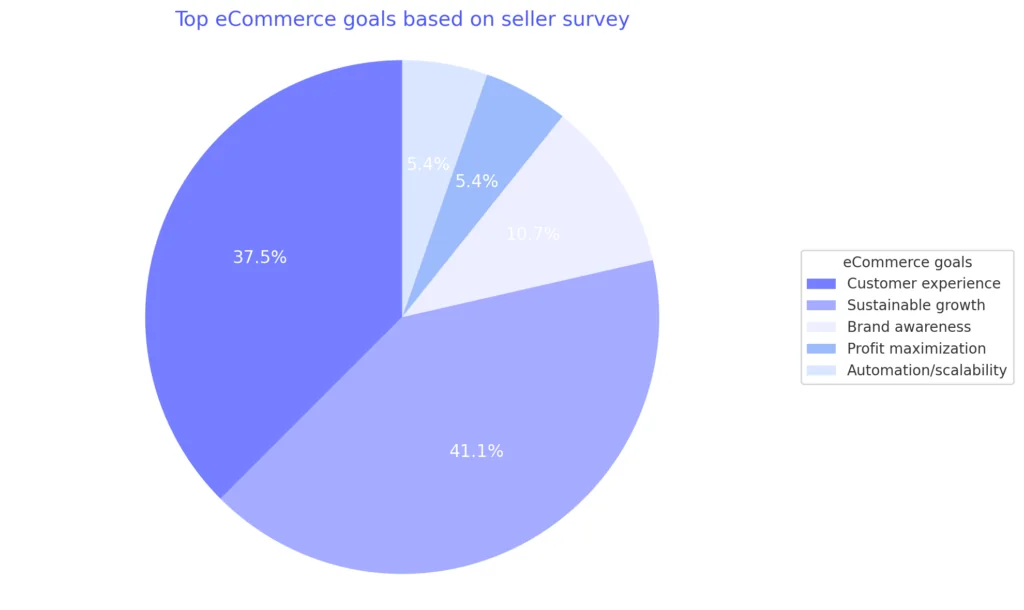What’s the top priority for eCommerce business owners today? We surveyed a diverse group of sellers and industry experts to discover their number one goal. From improving customer experience to fostering sustainable growth, the responses of over 50 industry individuals highlight the key strategies driving success in the evolving eCommerce landscape.
Whether your focus is on growth, brand awareness, or profitability – these findings offer valuable insights for every eCommerce entrepreneur.
In this article, we’ll break down the results and share lessons from some of the industry’s most innovative leaders.
Key findings at a glance
Our survey revealed that the 58 industry leaders who answered prioritize five key areas. Here’s a breakdown of their top goals:
- Sustainable growth: 41.07%
- Customer experience: 37.5%
- Brand awareness: 10.71%
- Profit maximization: 5.36%
- Automation / scalability: 5.36%

A detailed breakdown of the data
Sustainable growth (41.1%)
Sustainable growth topped the list for 41.1% of our surveyed eCommerce business owners. These sellers are focused on scaling their businesses in a way that ensures long-term success while staying adaptable to changing markets and evolving customer needs. Whether through automation, keeping up with industry trends, or developing a resilient business model, sustainable growth remains central to their strategies.
eCommerce entrepreneurs know that growth isn’t just about boosting sales today – it’s about laying the groundwork for future success. Here’s how some of them plan to achieve this:
My number one goal is growth through automation and scalability.
Chase Chappell Founder, Sirge

Chase Chappell’s strategy centers on using automation to drive scalability. By automating processes, his business, Sirge, can grow efficiently without sacrificing quality or customer experience. This approach enables eCommerce companies to manage higher volumes while maintaining the same top-tier service – an essential factor for achieving sustainable growth.
Subscribe to the eCommerce newsletter for
top industry insights
Ultimately, the top aim… is to create an enterprise that grows sustainably and remains profitable. It’s about constructing a resilient model that adapts to the ever-evolving market and supplies actual cost to customers.
Alison Hilton Managing director, Switch Jam Digital

Alison emphasizes the importance of resilience in achieving sustainable growth. His focus, as part of his work at Switch Jam Digital, is on creating a business model that can adapt to market shifts while consistently delivering value to customers. This flexibility is crucial for long-term success, ensuring the business stays relevant and profitable as industry dynamics evolve.
My primary goal is always to stay on top of new developments in the medical device industry and the regulatory landscape.
Soumya Mahapatra CEO, Essenvia

For Soumya, staying informed on industry developments is a core component of Essenvia‘s sustainable growth strategy. As the regulatory landscape and market trends evolve, staying up to date helps his business remain both competitive and compliant, securing long-term success in a specialized market like the healthcare industry.
Sustainable growth goes beyond scaling – it’s about building a business that thrives for years to come. By prioritizing automation, staying ahead of industry changes, and optimizing customer experiences, eCommerce sellers are embedding resilience into their strategies. With tools like 8fig’s financial support, these businesses can scale steadily, ensuring growth and adaptability as the market evolves.
Customer experience (37.5%)
Improving customer experience stood out as the top priority for most participants, with 37.5% of respondents highlighting the need for a seamless, personalized journey. By prioritizing user experience (UX) and customer satisfaction, these sellers are focused on building loyalty, driving repeat purchases, and strengthening their brand reputation.
From streamlining navigation to delivering tailored experiences, these eCommerce leaders understand that happy customers are the key to a thriving business. Here’s what some of them had to say:
Enhancing customer experience is my primary objective in eCommerce, as it allows development of trustworthy relationships and ensures the customers come back by providing suitable and personalized experiences.
Yosef Adde Owner, I BUY LA

Yosef underscores the importance of personalized experiences within I BUY LA, highlighting how they cultivate trust and customer loyalty. His insight reflects a growing trend in eCommerce, where personalization is being leveraged to boost repeat sales and build long-term customer relationships.
Our absolute number one goal is to constantly enhance the customer experience, making our websites easier to navigate through UX/UI audits and more pleasant for our customers overall.
Drew Mansur Co-founder and director, TileCloud and Yabby

Drew highlights the technical side of customer experience, focusing on improving navigation and ease of use through regular UX/UI audits in his businesses Yabby and TileCloud. By continuously refining their digital storefronts, sellers like Drew are ensuring that customers enjoy a smooth and intuitive shopping journey.
In eCommerce, our chief aim is to optimize the path of the customer to the end purchase and maximize conversion rates by embedding AI-enabled solutions of personalization for executive technologies.
Jonathan Ayala Founder and CEO, Hudson Condos

Jonathan takes a tech-driven approach to customer experience by leveraging AI-powered personalization to enhance the customer journey at Hudson Condos. By integrating cutting-edge technology, his business ensures that every interaction feels tailored to individual preferences, resulting in higher conversion rates and improved customer satisfaction.
Whether through personalization, enhanced UX/UI, or AI-powered solutions, eCommerce business owners recognize that customer experience is vital to their success. By investing in the customer journey – whether it’s optimizing navigation or delivering tailored offers – sellers can build strong relationships that drive brand loyalty, thus repeating sales.
Might also interest you:
- Proven strategies to take your eCommerce business to the next level
- 14 strategies to improve your eCommerce business’s financial health
- How to increase your eCommerce conversion rate
Brand awareness (10.7%)
For 10.7% of respondents, building a strong brand is the top priority. These business owners recognize that in today’s competitive landscape, a recognizable brand can boost sales and foster customer loyalty. By focusing on brand awareness, sellers aim to make a lasting impression that not only keeps customers returning but also attracts new leads.
A strong brand goes beyond logos and taglines; it’s about shaping how customers perceive the business and the values it represents. Here’s what some sellers had to say:
The number one goal of our eCommerce effort is to spread brand awareness and develop more leads.
Ryan Farley CEO, LawnStarter

Ryan emphasizes the importance of brand awareness in reaching new customers with his business LawnStarter. By building recognition, his business opens the door to more lead generation opportunities, driving growth and expanding the customer base.
My number one goal for our eCommerce presence is to make sure that we build brand awareness and represent ourselves well.
Rafi Friedman President, Coastal Luxury Nocatee Pool Builders

For Rafi, brand awareness goes beyond reaching new audiences – it’s about making sure his company, Coastal Luxury Nocatee Pool Builders, is represented in a way that aligns with its values and reputation. By focusing on perception, his business builds stronger relationships with customers, fostering greater trust and loyalty in a highly competitive market.
The primary goal has always been creating an unforgettable brand experience for parents.
Yuki Yang Manager, Kabeier

Yuki’s approach to brand awareness is all about building an emotional connection with her target audience at Kabeier. By delivering memorable experiences, her business ensures that customers not only recognize the brand but also feel a personal connection to it, which drives repeat purchases.
Brand awareness is essential for long-term success in eCommerce. A strong brand attracts new customers, builds trust, and encourages loyalty. By investing in brand-building strategies, eCommerce sellers can set themselves apart from competitors and create a lasting impact in the market.
Profit maximization (5.4%)
For 5.4% of the participants, maximizing profits is the top priority. These business owners are focused on boosting revenue while optimizing resources by cutting costs, streamlining operations, or improving efficiency, among other methods. The challenge is finding ways to enhance the bottom line without compromising product or service quality.
Here’s how some eCommerce entrepreneurs are driving profitability while staying efficient:
My top priority is to increase profits while cutting down on effort and time.
Andrew Johnson Digital strategist, Giveaways.org
Andrew’s strategy for maximizing profitability centers on efficiency. By streamlining workflows and optimizing resources at Giveaways.org, he minimizes unnecessary effort and time while still driving revenue. This approach enables him to maintain quality without compromising profitability.
The number one goal I hear most often is scalability.
Lissa Poirot Head of content, Joy Wallet
Lissa’s focus on scalability demonstrates a strategic approach to profit maximization. By scaling their operations, the eCommerce sellers she interacts with at Joy Wallet benefit from economies of scale, lowering costs as they continue to grow. This long-term strategy ensures that as revenue increases, operational expenses remain controlled, leading to greater profitability.
I aim to increase our average order value by 15% within 6 months by introducing a personalized ‘Firework Bundle’ offer.
Saj Munir CEO, Chorlton Fireworks
Saj’s strategy for Chorlton Fireworks revolves around increasing the average order value (AOV) through personalized offers. By creating tailored bundles, he encourages customers to make larger purchases, driving profitability without needing to expand his customer base. This approach not only boosts revenue but also enhances the customer experience through customized deals.
Maximizing profits isn’t just about cutting costs – it’s about smarter strategies that drive revenue. By focusing on efficiency, increasing AOV, and implementing data-driven tactics, these eCommerce sellers are boosting profitability while upholding quality. Streamlined operations and strategic growth are essential to making every dollar count.
Automation and scalability (5.4%)
For 5.4% of eCommerce sellers, scalability through automation is the top priority. These business owners recognize that as their businesses expand, manual processes can lead to bottlenecks. By modernizing their businesses and automating key operations, they can scale efficiently without sacrificing customer experience or operational performance.
Popular content
- 14 strategies to improve your eCommerce business’s financial health
- 50+ ChatGPT prompts to elevate your eCommerce business
- A guide to pricing your product on Amazon
- 5 marketing metrics all eCommerce businesses should track
- All about Amazon PPC
Automation enables these sellers to manage higher volumes, minimize errors, and maintain smooth operations, all while staying focused on growth.
Here’s how they are leveraging automation to fuel their expansion:
The number one goal in eCommerce is to drive sustainable revenue growth through a seamless and optimized customer journey.
Gregory Shein CEO, Corcava

Gregory’s emphasis on a seamless customer journey at Corcava is powered by automation. By automating various aspects of the customer experience, his business ensures that every interaction is consistent and optimized, especially as the company scales. This approach enables sustainable revenue growth without the constant need to expand resources.
Our main goal is to dominate our niche through automation, allowing us to reach more customers without increasing overhead.
Brandon Hartman Founder, BeyWarehouse

Brandon’s strategy for BeyWarehouse is all about using automation to dominate his market. By automating processes like inventory management and customer communication, he scales his business without significantly raising overhead costs. This lean and efficient approach enables him to reach more customers while keeping operations streamlined.
As we’ve seen, automation is a game-changer for scaling eCommerce businesses efficiently. Whether it’s managing the customer journey or streamlining operations, automation allows sellers to grow without straining their resources. With the right systems in place, businesses can handle increased demand, drive sustainable growth, and keep operations smooth – ensuring consistent and high-quality customer experiences.
Conclusion
Across the eCommerce landscape, key objectives such as enhancing customer experience, driving sustainable growth, increasing brand awareness, maximizing profit, and scaling through automation are all deeply connected. Focusing on one goal often fuels progress on the others. For instance, investing in a seamless customer experience not only fosters loyalty but can also drive sustainable growth through repeat purchases. Likewise, optimizing operations with automation enables businesses to scale efficiently, leading to increased profitability.
The common thread linking all these goals is flexibility. As the eCommerce space evolves, sellers must adapt in order to thrive. That’s why 8fig is here – with flexible funding solutions and tailored Growth Plans, eCommerce sellers can accomplish their most important goals. From financial management tools to custom growth strategies, 8fig supports businesses at every step, empowering them to scale, stay profitable, and build a resilient brand.
Ready to grow your eCommerce business? With 8fig’s dynamic funding and powerful growth tools, you too can achieve your top goal – whatever that may be.
Have article ideas, requests, or collaboration proposals? Reach out to us at editor@8fig.co – we’d love to hear from you.
- A complete guide to designing an ideal eCommerce landing page
- BFCM: The ultimate guide to eCommerce sales [2024]
- How to optimize your supply chain for the holiday season
- Holiday rush readiness: top 8 tips for handling seasonal demand peaks
- Why APR is key in eCommerce funding (and interest rate is not)
She's a former English teacher who's passionate about the written word, all while embracing the AI revolution and its countless benefits.
Subscribe to the eCommerce newsletter for
top industry insights
to our blog
Read the latest
from 8fig

AI is quietly reshaping eCommerce. Karma’s Hadas Bar-Ad explores how today’s sellers are using intelligent tools to streamline operations, boost efficiency, and drive smarter growth.

WhatsApp isn’t just for memes and group chats anymore. With a 98% open rate, it’s the secret weapon your eCommerce marketing strategy might be missing. Here’s how to do it right.

Stuck with extra inventory after Amazon’s Spring Sale? Learn five smart strategies to clear unsold stock, boost cash flow, and avoid future overstocks with smarter inventory planning.
